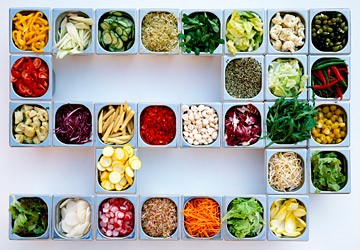Involve the whole family. Dinner doesn't need to be assembled by only one person. Young children can help wash veggies; older kids can peel, chop, or load the blender for a smoothie.
And dinner doesn't need to be a big production - getting away from a "meat and two sides" gives you the opportunity to innovate. Serve a salad and a smoothie on a hot August evening, or roasted root vegetables and crusty, multigrain bread on a cold January night.
Avoid the X factor - exhaustion! Choices are great and it's wonderful to have them. But we can overthink our choices, drive ourselves to distraction and ultimately, give up. So make a conscious choice to limit your choices. You don't need to research which bread has the absolute best mix of nutrients for your body, mind, and future health. Bread is a great way to get fiber. So pick a few that taste good, flip them over and look at the label; put back anything that has trans fat or less than 3 grams of fiber. Then pick the one with the lowest sodium. Done!
The Bottom Line
 To get the most out of your food, choose fresh foods when you can. Local foods are ideal because they're harvested ripe, as opposed to fruit that's expected to ripen as it travels. When you can't buy fresh, frozen is also a good option. Just be careful to reheat fruits and vegetables gently to retain their nutrients. And if you do choose canned fruits or vegetables, pay close attention to how they're packaged (preferably in water, not syrup) and read the label for additives so you know exactly what you're getting.
To get the most out of your food, choose fresh foods when you can. Local foods are ideal because they're harvested ripe, as opposed to fruit that's expected to ripen as it travels. When you can't buy fresh, frozen is also a good option. Just be careful to reheat fruits and vegetables gently to retain their nutrients. And if you do choose canned fruits or vegetables, pay close attention to how they're packaged (preferably in water, not syrup) and read the label for additives so you know exactly what you're getting.
Foods packaged for convenience are a great option to have - anyone who breaks out a can or bag of frozen peaches in January knows it's nice to have a bit of sweet summer in the middle of winter. But compared to a fresh, in-season peach? Try it yourself sometime and see what you think.
Eating Right: Common Questions Answered
OK, so you're determined to eat right and avoid the nutritional perils of processed foods. That means eating fresh, which means incorporating fruits, vegetables, whole grains, nuts and lean meat into your diet, among other healthy options. Easier said than done? Here are a few suggestions from registered dietitian Sandy Sfikas:
Q: How do you suggest people add more fruits and vegetables to their diet?
A: I recommend frozen vegetables and frozen fruit, especially berries. You can throw them in cereal, yogurt, or make a smoothie.
Q: But what if I don't like fruits or vegetables, or other healthy foods like fish?
A: There is no way around the fact that we all need our fruits and veggies. For those who absolutely hate them, I strongly suggest a multivitamin. But before that, I talk them through all different types that they may have not tried before. That's my job, to introduce different foods. I do see people who don't like fish. So I encourage other foods with monounsaturated fats and omega 3s like walnuts, olives, peanut butter, and flax seed. If they have any history or indication of heart disease, I may suggest an omega 3 supplement.
Q: What are some good packaged foods that still provide good nutrition?
A: I recommend things like 100-calorie packs of almonds, light cheese wedges, Greek yogurt, dried fruit [with no added sugar], broccoli slaw or other packaged salad mixes, 70% cocoa dark chocolate bars, low-fat microwave popcorn as a great source of whole grains, low-fat string cheese, skim milk, and whole-grain cereals.
Sara Tiner, BA, BS, MS, is the coordinator of scientific communication for a whole-food supplement manufacturer in Wisconsin. With undergraduate degrees in biology and English from Ripon College, and a master's degree in journalism from Columbia University, she's worked as a science writer in both print and radio over the past decade, and moonlights as a freelance contributor to various publications.

